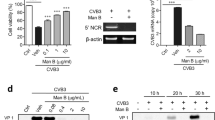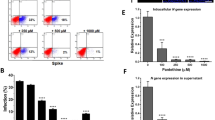Abstract
Coxsackievirus B3 (CVB3) is a human pathogen that causes acute and chronic infections, but an antiviral drug to treat these diseases has not yet been developed for clinical use. Several intracellular pathways are altered to assist viral transcription, RNA replication, and progeny release. Among these, fatty acid synthase (FAS) expression is increased. In order to test the potential of FAS inhibition as an anti-CVB3 strategy, several experiments were performed, including studies on the correlation of CVB3 replication and FAS expression in human Raji cells and an analysis of the time and dose dependence of the antiviral effect of FAS inhibition due to treatment with amentoflavone. The results demonstrate that CVB3 infection induces an up-regulation of FAS expression already at 1 h postinfection (p.i.). Incubation with increasing concentrations of amentoflavone inhibited CVB3 replication significantly up to 8 h p.i. In addition, suppression of p38 MAP kinase activity by treatment with SB239063 decreased FAS expression as well as viral replication. These data provide evidence that FAS inhibition via amentoflavone administration might present a target for anti-CVB3 therapy.







Similar content being viewed by others
References
Gupta S, Markham DW, Drazner MH, Mammen PP (2008) Fulminant myocarditis. Nat Clin Pract Cardiovasc Med 5(11):693–706
Badorff C, Knowlton KU (2004) Dystrophin disruption in enterovirus-induced myocarditis and dilated cardiomyopathy: from bench to bedside. Med Microbiol Immunol 193(2–3):121–126
Martin U, Nestler M, Munder T, Zell R, Sigusch HH, Henke A (2004) Characterization of coxsackievirus B3-caused apoptosis under in vitro conditions. Med Microbiol Immunol (Berl) 193(2–3):133–139
Heim A, Weiss S (2004) Interferons in enteroviral heart disease: modulation of cytokine expression and antiviral activity. Med Microbiol Immunol 193(2–3):149–154
Klingel K, Sauter M, Bock CT, Szalay G, Schnorr JJ, Kandolf R (2004) Molecular pathology of inflammatory cardiomyopathy. Med Microbiol Immunol 193(2–3):101–107
Rabenau HF, Richter M, Doerr HW (2010) Hand, foot and mouth disease: seroprevalence of Coxsackie A16 and Enterovirus 71 in Germany. Med Microbiol Immunol 199(1):45–51
Whitton JL, Cornell CT, Feuer R (2005) Host and virus determinants of picornavirus pathogenesis and tropism. Nat Rev Microbiol 3(10):765–776
Esfandiarei M, McManus BM (2008) Molecular biology and pathogenesis of viral myocarditis. Annu Rev Pathol 3:127–155
Vuorinen T, Vainionpaa R, Heino J, Hyypia T (1999) Enterovirus receptors and virus replication in human leukocytes. J Gen Virol 80(Pt 4):921–927
Mena I, Perry CM, Harkins S, Rodriguez F, Gebhard J, Whitton JL (1999) The role of B lymphocytes in coxsackievirus B3 infection. Am J Pathol 155(4):1205–1215
Vuorinen T, Vainionpaa R, Kettinen H, Hyypia T (1994) Coxsackievirus B3 infection in human leukocytes and lymphoid cell lines. Blood 84(3):823–829
Matteucci D, Paglianti M, Giangregorio AM, Capobianchi MR, Dianzani F, Bendinelli M (1985) Group B coxsackieviruses readily establish persistent infections in human lymphoid cell lines. J Virol 56(2):651–654
Jarasch N, Martin U, Zell R, Wutzler P, Henke A (2007) Influence of pan-caspase inhibitors on coxsackievirus B3-infected CD19+ B lymphocytes. Apoptosis 12:1633–1643
Klingel K, McManus BM, Kandolf R (1995) Enterovirus-infected immune cells of spleen and lymph nodes in the murine model of chronic myocarditis: a role in pathogenesis? Eur Heart J 16(Suppl O):42–45
Anderson DR, Wilson JE, Carthy CM, Yang D, Kandolf R, McManus BM (1996) Direct interactions of coxsackievirus B3 with immune cells in the splenic compartment of mice susceptible or resistant to myocarditis. J Virol 70(7):4632–4645
Kandolf R, Sauter M, Aepinus C, Schnorr JJ, Selinka HC, Klingel K (1999) Mechanisms and consequences of enterovirus persistence in cardiac myocytes and cells of the immune system. Virus Res 62(2):149–158
Magnani JW, Dec GW (2006) Myocarditis: current trends in diagnosis and treatment. Circulation 113(6):876–890
Henke A, Jarasch N, Wutzler P (2008) Coxsackievirus B3 vaccines: use as an expression vector for prevention of myocarditis. Expert Rev Vaccines 7(10):1557–1567
Esfandiarei M, Suarez A, Amaral A, Si X, Rahmani M, Dedhar S, McManus BM (2006) Novel role for integrin-linked kinase in modulation of coxsackievirus B3 replication and virus-induced cardiomyocyte injury. Circ Res 99(4):354–361
Esfandiarei M, Boroomand S, Suarez A, Si X, Rahmani M, McManus B (2007) Coxsackievirus B3 activates nuclear factor kappa B transcription factor via a phosphatidylinositol-3 kinase/protein kinase B-dependent pathway to improve host cell viability. Cell Microbiol 9(10):2358–2371
Feuer R, Mena I, Pagarigan RR, Hassett DE, Whitton JL (2004) Coxsackievirus replication and the cell cycle: a potential regulatory mechanism for viral persistence/latency. Med Microbiol Immunol 193(2–3):83–90
Rassmann A, Henke A, Zobawa M, Carlsohn M, Saluz HP, Grabley S, Lottspeich F, Munder T (2006) Proteome alterations in human host cells infected with coxsackievirus B3. J Gen Virol 87(Pt 9):2631–2638
Li Y, Webster-Cyriaque J, Tomlinson CC, Yohe M, Kenney S (2004) Fatty acid synthase expression is induced by the Epstein-Barr virus immediate-early protein BRLF1 and is required for lytic viral gene expression. J Virol 78(8):4197–4206
Wakil SJ (1989) Fatty acid synthase, a proficient multifunctional enzyme. Biochemistry 28(11):4523–4530
Belov GA, Ehrenfeld E (2007) Involvement of cellular membrane traffic proteins in poliovirus replication. Cell Cycle 6(1):36–38
Kemball CC, Alirezaei M, Flynn CT, Wood MR, Harkins S, Kiosses WB, Whitton JL (2010) Coxsackievirus infection induces autophagy-like vesicles and megaphagosomes in pancreatic acinar cells in vivo. J Virol 84(23):12110–12124
Van Kuppeveld FJ, Hoenderop JG, Smeets RL, Willems PH, Dijkman HB, Galama JM, Melchers WJ (1997) Coxsackievirus protein 2B modifies endoplasmic reticulum membrane and plasma membrane permeability and facilitates virus release. EMBO J 16(12):3519–3532
Lin YM, Anderson H, Flavin MT, Pai YH, Mata-Greenwood E, Pengsuparp T, Pezzuto JM, Schinazi RF, Hughes SH, Chen FC (1997) In vitro anti-HIV activity of biflavonoids isolated from Rhus succedanea and Garcinia multiflora. J Nat Prod 60(9):884–888
Lin YM, Flavin MT, Schure R, Chen FC, Sidwell R, Barnard DL, Huffman JH, Kern ER (1999) Antiviral activities of biflavonoids. Planta Med 65(2):120–125
Ma SC, But PP, Ooi VE, He YH, Lee SH, Lee SF, Lin RC (2001) Antiviral amentoflavone from Selaginella sinensis. Biol Pharm Bull 24(3):311–312
Lee JS, Lee MS, Oh WK, Sul JY (2009) Fatty acid synthase inhibition by amentoflavone induces apoptosis and antiproliferation in human breast cancer cells. Biol Pharm Bull 32(8):1427–1432
Knowlton KU, Jeon ES, Berkley N, Wessely R, Huber S (1996) A mutation in the puff region of VP2 attenuates the myocarditic phenotype of an infectious cDNA of the Woodruff variant of coxsackievirus B3. J Virol 70(11):7811–7818
Slifka MK, Pagarigan R, Mena I, Feuer R, Whitton JL (2001) Using recombinant coxsackievirus B3 to evaluate the induction and protective efficacy of CD8+ T cells during picornavirus infection. J Virol 75(5):2377–2387
Verstrepen WA, Kuhn S, Kockx MM, Van De Vyvere ME, Mertens AH (2001) Rapid detection of enterovirus RNA in cerebrospinal fluid specimens with a novel single-tube real-time reverse transcription-PCR assay. J Clin Microbiol 39(11):4093–4096
Pfaffl MW (2001) A new mathematical model for relative quantification in real-time RT-PCR. Nucleic Acids Res 29(9):e45
Jarasch-Althof N, Wiesener N, Schmidtke M, Wutzler P, Henke A (2010) Antibody-dependent enhancement of coxsackievirus B3 infection of primary CD19+ B lymphocytes. Viral Immunol 23(4):369–376
Nissen E, Pauli G, Vollenbroich D (1997) WST-1 assay–a simple colorimetric method for virus titration. In Vitro Cell Dev Biol Anim 33(1):28–29
Ngamwongsatit P, Banada PP, Panbangred W, Bhunia AK (2008) WST-1-based cell cytotoxicity assay as a substitute for MTT-based assay for rapid detection of toxigenic Bacillus species using CHO cell line. J Microbiol Methods 73(3):211–215
Dowling S, Cox J, Cenedella RJ (2009) Inhibition of fatty acid synthase by Orlistat accelerates gastric tumor cell apoptosis in culture and increases survival rates in gastric tumor bearing mice in vivo. Lipids 44(6):489–498
Browne CD, Hindmarsh EJ, Smith JW (2006) Inhibition of endothelial cell proliferation and angiogenesis by orlistat, a fatty acid synthase inhibitor. FASEB J 20(12):2027–2035
Gao F, Yue TL, Shi DW, Christopher TA, Lopez BL, Ohlstein EH, Barone FC, Ma XL (2002) p38 MAPK inhibition reduces myocardial reperfusion injury via inhibition of endothelial adhesion molecule expression and blockade of PMN accumulation. Cardiovasc Res 53(2):414–422
King EM, Holden NS, Gong W, Rider CF, Newton R (2009) Inhibition of NF-kappaB-dependent transcription by MKP-1: transcriptional repression by glucocorticoids occurring via p38 MAPK. J Biol Chem 284(39):26803–26815
Rassmann A, Henke A, Jarasch N, Lottspeich F, Saluz HP, Munder T (2007) The human fatty acid synthase: a new therapeutic target for coxsackievirus B3-induced diseases? Antiviral Res 76(2):150–158
Chang L, Karin M (2001) Mammalian MAP kinase signalling cascades. Nature 410(6824):37–40
Huttunen P, Hyypia T, Vihinen P, Nissinen L, Heino J (1998) Echovirus 1 infection induces both stress- and growth-activated mitogen-activated protein kinase pathways and regulates the transcription of cellular immediate-early genes. Virology 250(1):85–93
Tung WH, Sun CC, Hsieh HL, Wang SW, Horng JT, Yang CM (2007) EV71 induces VCAM-1 expression via PDGF receptor, PI3-K/Akt, p38 MAPK, JNK and NF-kappaB in vascular smooth muscle cells. Cell Signal 19(10):2127–2137
Guinea R, Carrasco L (1990) Phospholipid biosynthesis and poliovirus genome replication, two coupled phenomena. EMBO J 9(6):2011–2016
Fogg MH, Teterina NL, Ehrenfeld E (2003) Membrane requirements for uridylylation of the poliovirus VPg protein and viral RNA synthesis in vitro. J Virol 77(21):11408–11416
Feuer R, Mena I, Pagarigan R, Slifka MK, Whitton JL (2002) Cell cycle status affects coxsackievirus replication, persistence, and reactivation in vitro. J Virol 76(9):4430–4440
Knowles LM, Axelrod F, Browne CD, Smith JW (2004) A fatty acid synthase blockade induces tumor cell-cycle arrest by down-regulating Skp2. J Biol Chem 279(29):30540–30545
Guerciolini R (1997) Mode of action of orlistat. Int J Obes Relat Metab Disord 21(Suppl 3):S12–S23
Ballinger A, Peikin SR (2002) Orlistat: its current status as an anti-obesity drug. Eur J Pharmacol 440(2–3):109–117
Kridel SJ, Axelrod F, Rozenkrantz N, Smith JW (2004) Orlistat is a novel inhibitor of fatty acid synthase with antitumor activity. Cancer Res 64(6):2070–2075
Adhikari RP, Novick RP (2005) Subinhibitory cerulenin inhibits staphylococcal exoprotein production by blocking transcription rather than by blocking secretion. Microbiology 151(Pt 9):3059–3069
Chayakulkeeree M, Rude TH, Toffaletti DL, Perfect JR (2007) Fatty acid synthesis is essential for survival of Cryptococcus neoformans and a potential fungicidal target. Antimicrob Agents Chemother 51(10):3537–3545
Acknowledgments
The authors declare that they have no conflict of interest.
Author information
Authors and Affiliations
Corresponding author
Electronic supplementary material
Below is the link to the electronic supplementary material.
Rights and permissions
About this article
Cite this article
Wilsky, S., Sobotta, K., Wiesener, N. et al. Inhibition of fatty acid synthase by amentoflavone reduces coxsackievirus B3 replication. Arch Virol 157, 259–269 (2012). https://doi.org/10.1007/s00705-011-1164-z
Received:
Accepted:
Published:
Issue Date:
DOI: https://doi.org/10.1007/s00705-011-1164-z




